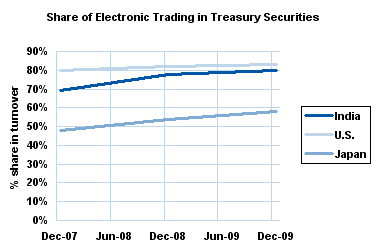E-Trading in the Indian Debt Markets: Growth in the Downturn
Abstract
India’s debt markets have experienced rapid growth. Electronic trading has also risen sharply, with the market growing at a CAGR over 75% since 2005. In spite of being a late starter, India is expected to have around 80% share of debt transactions being conducted electronically by the end of 2009, making it competitive with the US and Japan, the world’s leading global debt markets.
In a new report, E-Trading in the Indian Debt Market: Growth in the Downturn, Celent examines the Indian debt market infrastructure and the role electronic trading has played within it. India, which is growing at the rate of 5–6% and is one of the leading emerging markets, has a massive requirement for debt securities of all kind. It is important that the debt markets reach international standards and size so that there is an alternative to raising funds to the equity markets.

"Electronic trading has been crucial for the continued growth of the government bond market in India," says Anshuman Jaswal, Celent analyst and author of the report. "The problem, however, is that electronic trading is mainly dominated by a trading platform introduced by the central bank. As a result, the multiplatform model has not been successful in the market."
This report examines the development of the Indian debt markets, such as central government securities, state government loans/bonds, and corporate bonds. The report also looks at possible future areas of growth (i.e., in interdealer broking, which could add depth to the market).

